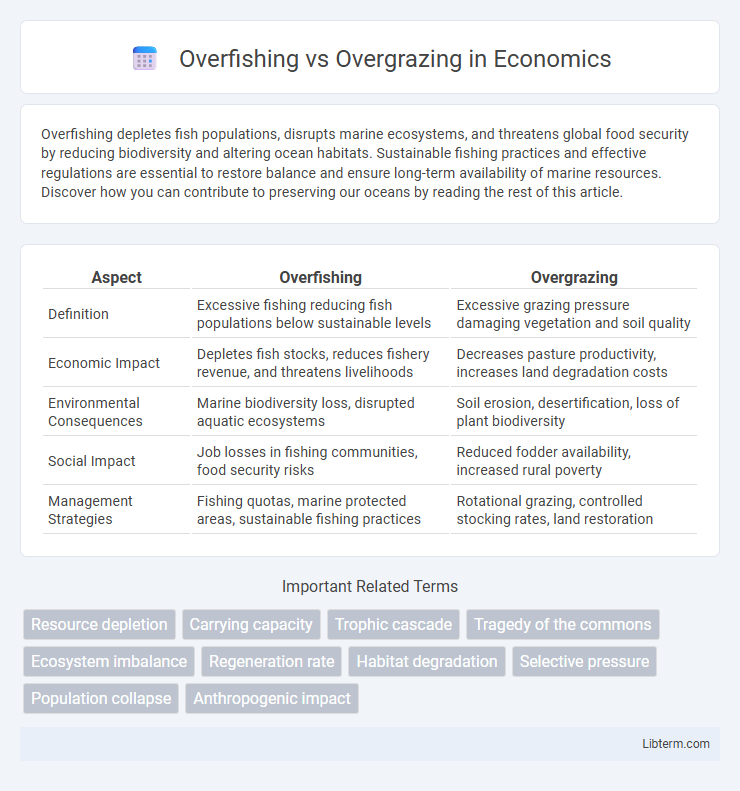Overfishing depletes fish populations, disrupts marine ecosystems, and threatens global food security by reducing biodiversity and altering ocean habitats. Sustainable fishing practices and effective regulations are essential to restore balance and ensure long-term availability of marine resources. Discover how you can contribute to preserving our oceans by reading the rest of this article.
Table of Comparison
| Aspect | Overfishing | Overgrazing |
|---|---|---|
| Definition | Excessive fishing reducing fish populations below sustainable levels | Excessive grazing pressure damaging vegetation and soil quality |
| Economic Impact | Depletes fish stocks, reduces fishery revenue, and threatens livelihoods | Decreases pasture productivity, increases land degradation costs |
| Environmental Consequences | Marine biodiversity loss, disrupted aquatic ecosystems | Soil erosion, desertification, loss of plant biodiversity |
| Social Impact | Job losses in fishing communities, food security risks | Reduced fodder availability, increased rural poverty |
| Management Strategies | Fishing quotas, marine protected areas, sustainable fishing practices | Rotational grazing, controlled stocking rates, land restoration |
Understanding Overfishing: Causes and Consequences
Overfishing occurs when fish are caught at a faster rate than they can reproduce, leading to the depletion of marine populations and disruption of aquatic ecosystems. Key causes include advanced fishing technologies, high demand for seafood, and inadequate regulation or enforcement of fishing quotas. The consequences involve loss of biodiversity, collapse of commercial fish stocks, and negative impacts on food security and coastal economies.
What is Overgrazing? Definition and Impact
Overgrazing occurs when livestock consume vegetation faster than it can naturally regenerate, leading to soil degradation and loss of plant biodiversity. This environmental imbalance results in reduced land productivity, increased erosion, and desertification, severely impacting ecosystems and agricultural sustainability. The degradation caused by overgrazing compromises carbon sequestration and disrupts habitats vital for wildlife survival.
Comparing Overfishing and Overgrazing: Key Differences
Overfishing depletes marine populations, disrupting aquatic ecosystems by removing key species faster than they can reproduce, while overgrazing deteriorates terrestrial vegetation, causing soil erosion and loss of biodiversity. Overfishing primarily impacts ocean food chains and commercial fish stocks, whereas overgrazing affects land productivity and the health of grasslands and rangelands. The socioeconomic consequences differ: overfishing threatens global seafood supplies and fishing industries, whereas overgrazing undermines livestock farming and land sustainability.
Ecosystem Imbalance: Effects on Biodiversity
Overfishing causes a drastic decline in fish populations, disrupting marine food webs and leading to a loss of biodiversity in aquatic ecosystems. Overgrazing results in soil degradation and vegetation loss, which diminishes habitat availability and alters terrestrial species composition. Both practices drive ecosystem imbalance, reducing resilience and threatening the stability of diverse biological communities.
Socioeconomic Impacts of Overfishing vs Overgrazing
Overfishing depletes fish stocks, leading to reduced income for fishing communities and increased food insecurity in coastal regions reliant on seafood. Overgrazing degrades land quality, causing lower agricultural productivity and threatening the livelihoods of pastoralists through soil erosion and desertification. Both practices disrupt local economies by diminishing natural resource availability, exacerbating poverty and limiting sustainable development opportunities.
Climate Change Connections: Oceans and Grasslands
Overfishing disrupts marine ecosystems by depleting key species that regulate carbon cycles, reducing the ocean's capacity to sequester carbon and exacerbating climate change. Overgrazing in grasslands leads to soil degradation and loss of vegetation, diminishing carbon storage and increasing greenhouse gas emissions. Both overfishing and overgrazing undermine the natural climate regulation functions of oceans and grasslands, intensifying global warming effects.
Restoration Solutions: Sustainable Fisheries and Grazing
Restoration solutions for overfishing prioritize sustainable fisheries through practices like catch limits, habitat protection, and selective fishing gear to allow fish populations to recover. In combating overgrazing, sustainable grazing management involves rotational grazing, maintaining optimal stocking rates, and restoring native vegetation to prevent soil degradation and promote ecosystem balance. Both approaches emphasize ecosystem resilience and long-term productivity by integrating science-based policies and community engagement.
Policy Measures: Regulations and Enforcement
Effective policy measures addressing overfishing include strict catch limits, gear restrictions, and seasonal closures, enforced through satellite monitoring and on-board observers to ensure compliance. Overgrazing management relies on regulated grazing permits, rotational grazing systems, and restoration of degraded lands, supported by local enforcement agencies and community involvement. Both sectors benefit from integrated surveillance technologies and stakeholder engagement to enhance regulatory adherence and sustain ecosystem health.
Community Involvement in Conservation Efforts
Community involvement plays a crucial role in addressing overfishing and overgrazing by promoting sustainable practices and local stewardship. Fishing communities often participate in monitoring fish populations and enforcing seasonal bans, while pastoral communities engage in rotational grazing and habitat restoration. Empowering local populations with education and resources ensures long-term conservation success and biodiversity protection.
Future Outlook: Preventing Resource Depletion
Effective management strategies targeting overfishing and overgrazing are essential to prevent the depletion of marine and terrestrial resources by 2050. Implementing sustainable quotas, enhancing habitat restoration, and adopting advanced monitoring technologies will support ecosystem resilience and biodiversity conservation. Collaborative policymaking and stakeholder engagement play crucial roles in ensuring long-term resource availability and food security.
Overfishing Infographic

 libterm.com
libterm.com